BUMGT 5970 - Cultural Diversity & Inclusive Leadership Case Study
VerifiedAdded on 2023/06/11
|14
|2997
|70
Case Study
AI Summary
This case study analyzes the document “Leading for Change: a blueprint for cultural diversity and inclusive leadership 2016” and a speech by Dr. Tim Soutphommasane on cultural diversity in the workplace. It identifies problems related to leadership in multicultural organizations, including the lack of accurate data on employee ethnic backgrounds and potential conflicts arising from cultural differences. The study emphasizes the importance of updating organizational systems to better manage diversity, address cultural bias and discrimination, and promote inclusivity. Solutions include active leadership, promoting cultural unity, and leveraging the benefits of a diverse workforce. The study also highlights the role of organizations in showcasing the talents of diverse communities and recommends that leaders seek advice from senior leadership, organize diversity councils, and lead by example to foster harmony and achieve organizational goals. Desklib provides access to similar solved assignments and resources.
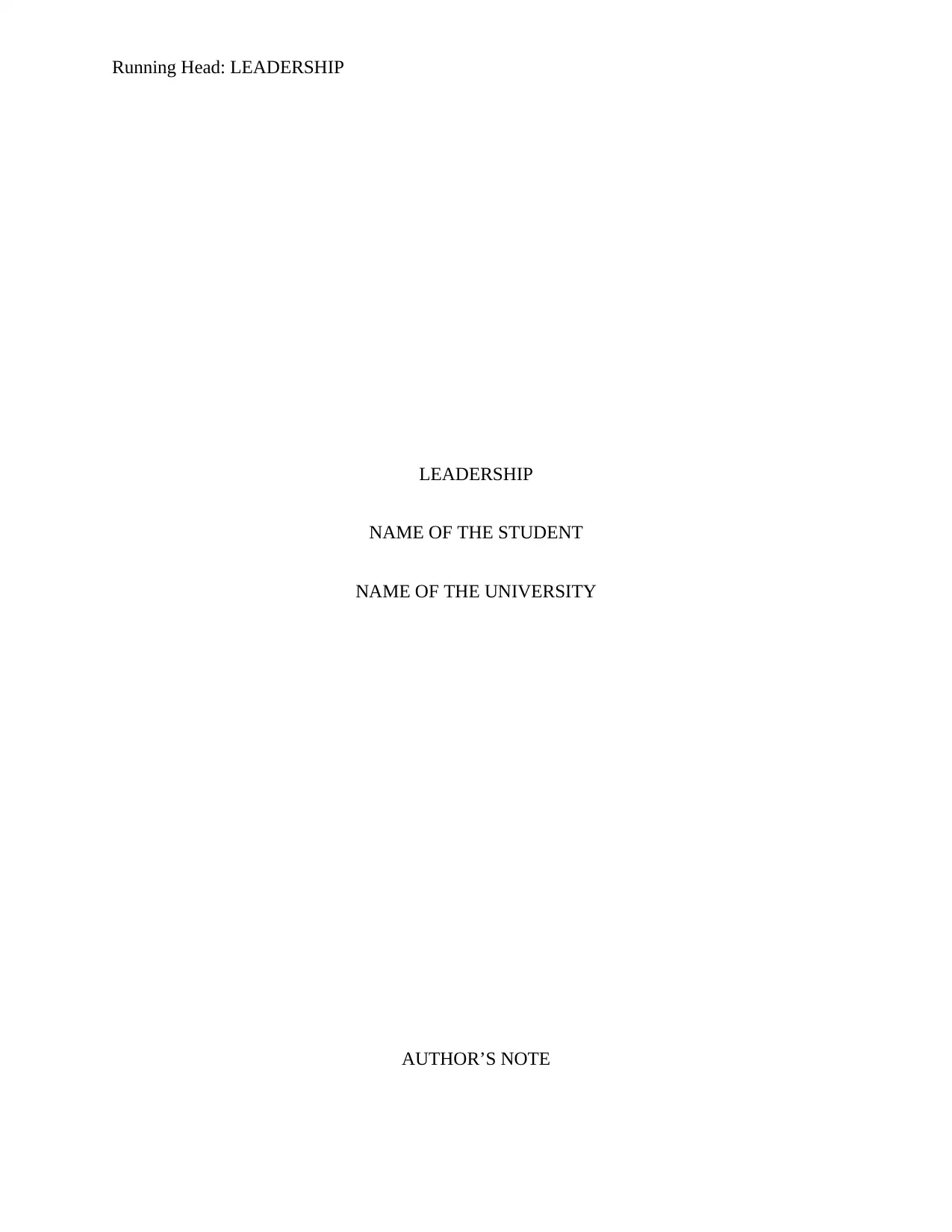
Running Head: LEADERSHIP
LEADERSHIP
NAME OF THE STUDENT
NAME OF THE UNIVERSITY
AUTHOR’S NOTE
LEADERSHIP
NAME OF THE STUDENT
NAME OF THE UNIVERSITY
AUTHOR’S NOTE
Paraphrase This Document
Need a fresh take? Get an instant paraphrase of this document with our AI Paraphraser
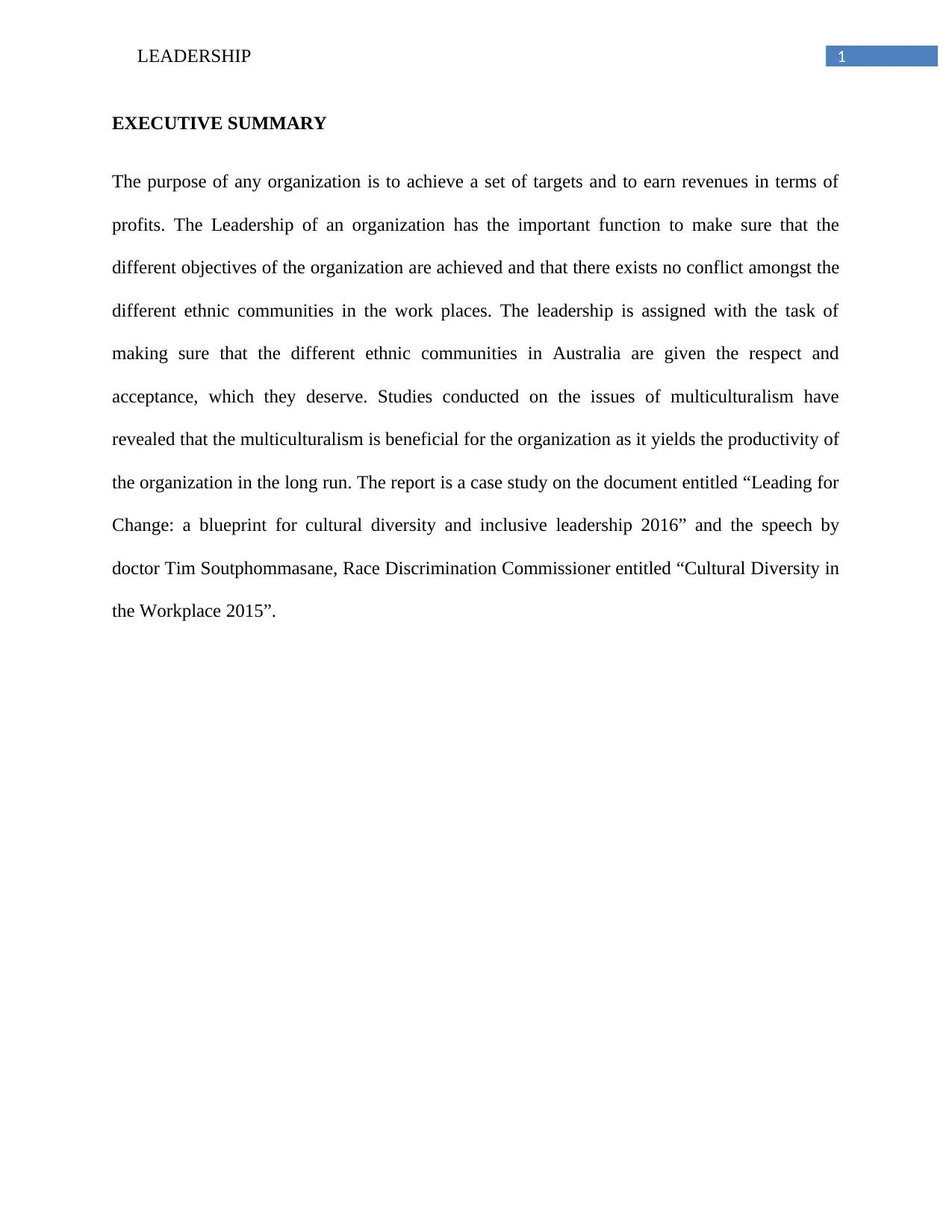
1LEADERSHIP
EXECUTIVE SUMMARY
The purpose of any organization is to achieve a set of targets and to earn revenues in terms of
profits. The Leadership of an organization has the important function to make sure that the
different objectives of the organization are achieved and that there exists no conflict amongst the
different ethnic communities in the work places. The leadership is assigned with the task of
making sure that the different ethnic communities in Australia are given the respect and
acceptance, which they deserve. Studies conducted on the issues of multiculturalism have
revealed that the multiculturalism is beneficial for the organization as it yields the productivity of
the organization in the long run. The report is a case study on the document entitled “Leading for
Change: a blueprint for cultural diversity and inclusive leadership 2016” and the speech by
doctor Tim Soutphommasane, Race Discrimination Commissioner entitled “Cultural Diversity in
the Workplace 2015”.
EXECUTIVE SUMMARY
The purpose of any organization is to achieve a set of targets and to earn revenues in terms of
profits. The Leadership of an organization has the important function to make sure that the
different objectives of the organization are achieved and that there exists no conflict amongst the
different ethnic communities in the work places. The leadership is assigned with the task of
making sure that the different ethnic communities in Australia are given the respect and
acceptance, which they deserve. Studies conducted on the issues of multiculturalism have
revealed that the multiculturalism is beneficial for the organization as it yields the productivity of
the organization in the long run. The report is a case study on the document entitled “Leading for
Change: a blueprint for cultural diversity and inclusive leadership 2016” and the speech by
doctor Tim Soutphommasane, Race Discrimination Commissioner entitled “Cultural Diversity in
the Workplace 2015”.
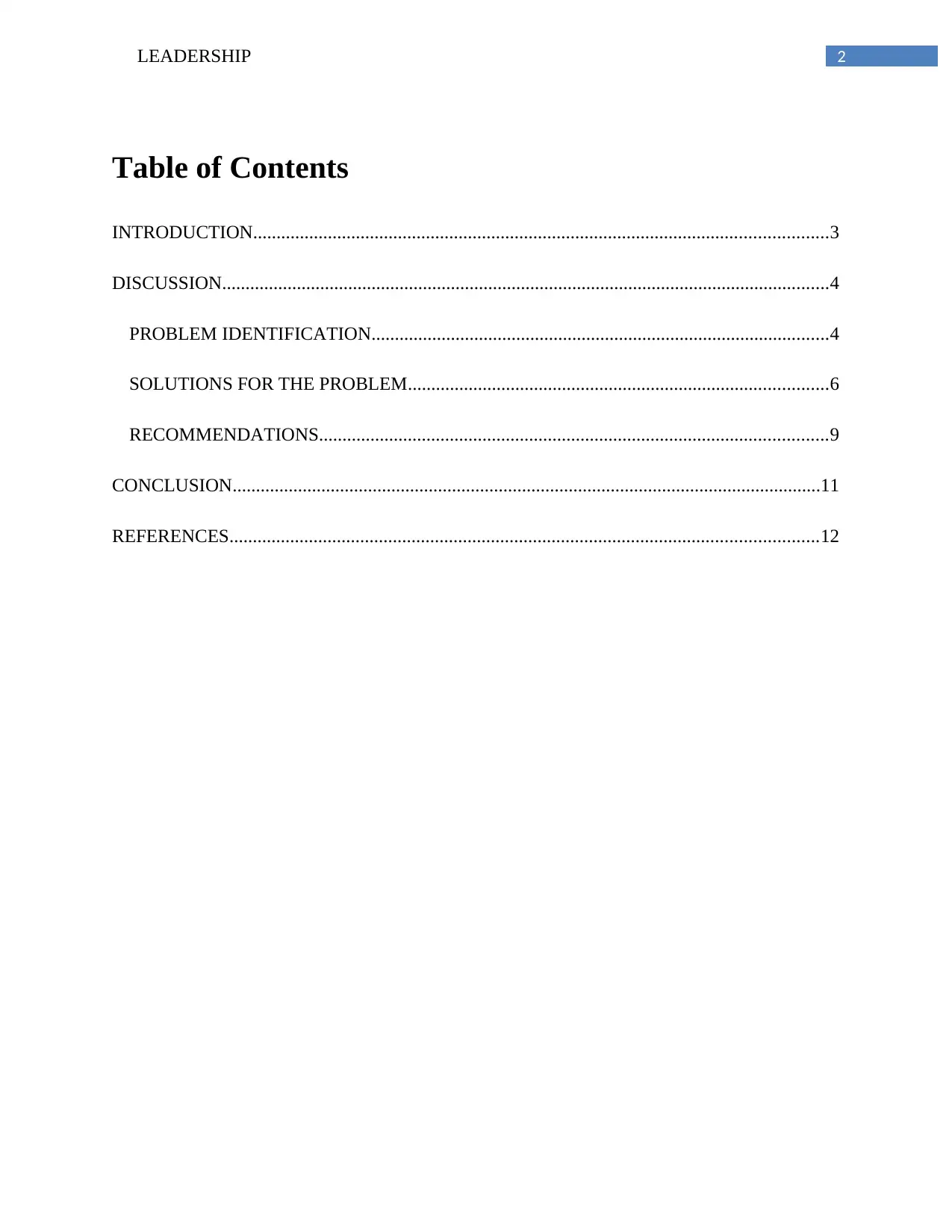
2LEADERSHIP
Table of Contents
INTRODUCTION...........................................................................................................................3
DISCUSSION..................................................................................................................................4
PROBLEM IDENTIFICATION..................................................................................................4
SOLUTIONS FOR THE PROBLEM..........................................................................................6
RECOMMENDATIONS.............................................................................................................9
CONCLUSION..............................................................................................................................11
REFERENCES..............................................................................................................................12
Table of Contents
INTRODUCTION...........................................................................................................................3
DISCUSSION..................................................................................................................................4
PROBLEM IDENTIFICATION..................................................................................................4
SOLUTIONS FOR THE PROBLEM..........................................................................................6
RECOMMENDATIONS.............................................................................................................9
CONCLUSION..............................................................................................................................11
REFERENCES..............................................................................................................................12
⊘ This is a preview!⊘
Do you want full access?
Subscribe today to unlock all pages.

Trusted by 1+ million students worldwide
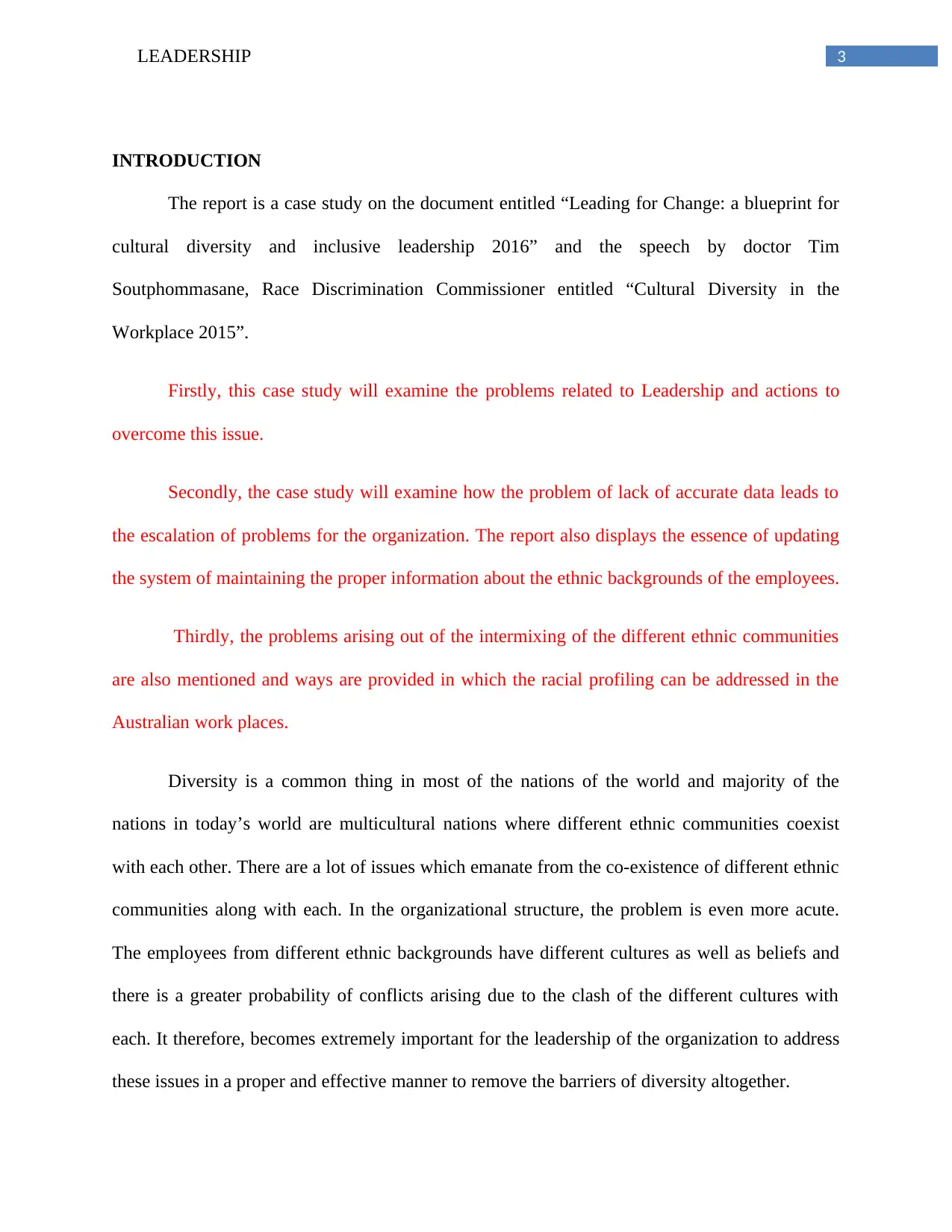
3LEADERSHIP
INTRODUCTION
The report is a case study on the document entitled “Leading for Change: a blueprint for
cultural diversity and inclusive leadership 2016” and the speech by doctor Tim
Soutphommasane, Race Discrimination Commissioner entitled “Cultural Diversity in the
Workplace 2015”.
Firstly, this case study will examine the problems related to Leadership and actions to
overcome this issue.
Secondly, the case study will examine how the problem of lack of accurate data leads to
the escalation of problems for the organization. The report also displays the essence of updating
the system of maintaining the proper information about the ethnic backgrounds of the employees.
Thirdly, the problems arising out of the intermixing of the different ethnic communities
are also mentioned and ways are provided in which the racial profiling can be addressed in the
Australian work places.
Diversity is a common thing in most of the nations of the world and majority of the
nations in today’s world are multicultural nations where different ethnic communities coexist
with each other. There are a lot of issues which emanate from the co-existence of different ethnic
communities along with each. In the organizational structure, the problem is even more acute.
The employees from different ethnic backgrounds have different cultures as well as beliefs and
there is a greater probability of conflicts arising due to the clash of the different cultures with
each. It therefore, becomes extremely important for the leadership of the organization to address
these issues in a proper and effective manner to remove the barriers of diversity altogether.
INTRODUCTION
The report is a case study on the document entitled “Leading for Change: a blueprint for
cultural diversity and inclusive leadership 2016” and the speech by doctor Tim
Soutphommasane, Race Discrimination Commissioner entitled “Cultural Diversity in the
Workplace 2015”.
Firstly, this case study will examine the problems related to Leadership and actions to
overcome this issue.
Secondly, the case study will examine how the problem of lack of accurate data leads to
the escalation of problems for the organization. The report also displays the essence of updating
the system of maintaining the proper information about the ethnic backgrounds of the employees.
Thirdly, the problems arising out of the intermixing of the different ethnic communities
are also mentioned and ways are provided in which the racial profiling can be addressed in the
Australian work places.
Diversity is a common thing in most of the nations of the world and majority of the
nations in today’s world are multicultural nations where different ethnic communities coexist
with each other. There are a lot of issues which emanate from the co-existence of different ethnic
communities along with each. In the organizational structure, the problem is even more acute.
The employees from different ethnic backgrounds have different cultures as well as beliefs and
there is a greater probability of conflicts arising due to the clash of the different cultures with
each. It therefore, becomes extremely important for the leadership of the organization to address
these issues in a proper and effective manner to remove the barriers of diversity altogether.
Paraphrase This Document
Need a fresh take? Get an instant paraphrase of this document with our AI Paraphraser

4LEADERSHIP
DISCUSSION
PROBLEM IDENTIFICATION
Leaders have an important duty to understand and comprehend cultural diversity in the
modern day organization. Diversity is a common phenomenon in many countries of the world
and more particular in Australia where half the population is the first generation Australian or the
second generation Australian.
The Australian Human Rights Commission Leadership for Change (2016), leading for
change publication has identified that the leaders in order to address the problem of leadership
arising due to the multiculturalism in the organization have the duty to promote cultural unity
in the organizations. Although, there are many positive aspects about the inclusiveness of the
various diverse ethnic cultures in the countries, yet there exist a number of problems also. The
multicultural societies, all over the world, are no strangers to the fact that social conflicts arise
from time to time amongst the different members of the society and to prevent these tensions
from escalating further, it is extremely important that the leadership of the nation or the
leadership of the organization formulate such plans and policies so as to properly address these
issues (Barak, Findler and Wind 2016).
The AHRC Leadership for Change (2016), leading for change identifies that the systems
of an organization need to be updated. The progress on addressing the cultural diversity will be
slow if the systems and the data of the total diversity are not updated and available with the
organization. In the absence of an increased data and figures of the organization, the organization
has a high chance of being in a problematic situation due to the conflicts, which might arise
amongst the employees hailing from different ethnic backgrounds (Torelli et al. 2014). The
DISCUSSION
PROBLEM IDENTIFICATION
Leaders have an important duty to understand and comprehend cultural diversity in the
modern day organization. Diversity is a common phenomenon in many countries of the world
and more particular in Australia where half the population is the first generation Australian or the
second generation Australian.
The Australian Human Rights Commission Leadership for Change (2016), leading for
change publication has identified that the leaders in order to address the problem of leadership
arising due to the multiculturalism in the organization have the duty to promote cultural unity
in the organizations. Although, there are many positive aspects about the inclusiveness of the
various diverse ethnic cultures in the countries, yet there exist a number of problems also. The
multicultural societies, all over the world, are no strangers to the fact that social conflicts arise
from time to time amongst the different members of the society and to prevent these tensions
from escalating further, it is extremely important that the leadership of the nation or the
leadership of the organization formulate such plans and policies so as to properly address these
issues (Barak, Findler and Wind 2016).
The AHRC Leadership for Change (2016), leading for change identifies that the systems
of an organization need to be updated. The progress on addressing the cultural diversity will be
slow if the systems and the data of the total diversity are not updated and available with the
organization. In the absence of an increased data and figures of the organization, the organization
has a high chance of being in a problematic situation due to the conflicts, which might arise
amongst the employees hailing from different ethnic backgrounds (Torelli et al. 2014). The
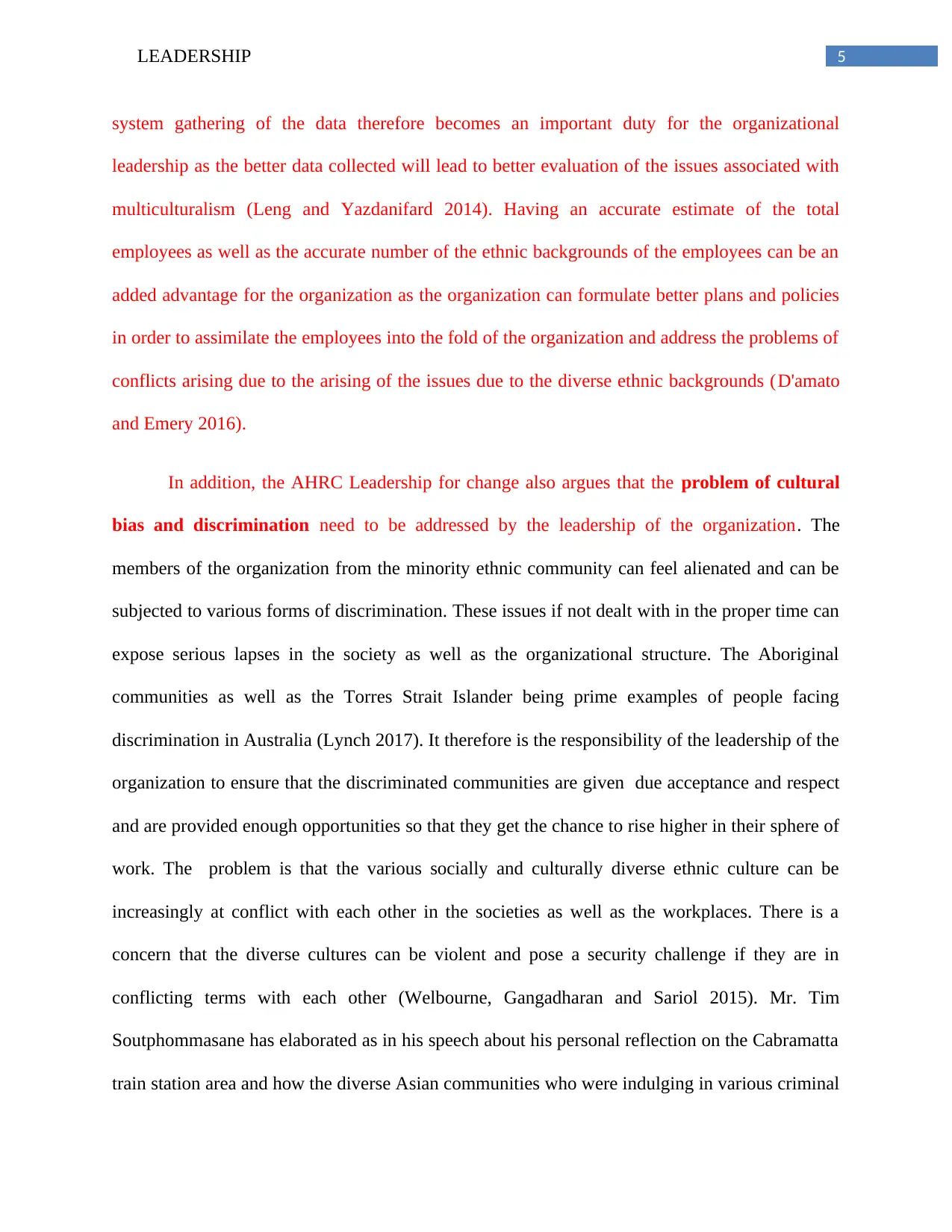
5LEADERSHIP
system gathering of the data therefore becomes an important duty for the organizational
leadership as the better data collected will lead to better evaluation of the issues associated with
multiculturalism (Leng and Yazdanifard 2014). Having an accurate estimate of the total
employees as well as the accurate number of the ethnic backgrounds of the employees can be an
added advantage for the organization as the organization can formulate better plans and policies
in order to assimilate the employees into the fold of the organization and address the problems of
conflicts arising due to the arising of the issues due to the diverse ethnic backgrounds (D'amato
and Emery 2016).
In addition, the AHRC Leadership for change also argues that the problem of cultural
bias and discrimination need to be addressed by the leadership of the organization. The
members of the organization from the minority ethnic community can feel alienated and can be
subjected to various forms of discrimination. These issues if not dealt with in the proper time can
expose serious lapses in the society as well as the organizational structure. The Aboriginal
communities as well as the Torres Strait Islander being prime examples of people facing
discrimination in Australia (Lynch 2017). It therefore is the responsibility of the leadership of the
organization to ensure that the discriminated communities are given due acceptance and respect
and are provided enough opportunities so that they get the chance to rise higher in their sphere of
work. The problem is that the various socially and culturally diverse ethnic culture can be
increasingly at conflict with each other in the societies as well as the workplaces. There is a
concern that the diverse cultures can be violent and pose a security challenge if they are in
conflicting terms with each other (Welbourne, Gangadharan and Sariol 2015). Mr. Tim
Soutphommasane has elaborated as in his speech about his personal reflection on the Cabramatta
train station area and how the diverse Asian communities who were indulging in various criminal
system gathering of the data therefore becomes an important duty for the organizational
leadership as the better data collected will lead to better evaluation of the issues associated with
multiculturalism (Leng and Yazdanifard 2014). Having an accurate estimate of the total
employees as well as the accurate number of the ethnic backgrounds of the employees can be an
added advantage for the organization as the organization can formulate better plans and policies
in order to assimilate the employees into the fold of the organization and address the problems of
conflicts arising due to the arising of the issues due to the diverse ethnic backgrounds (D'amato
and Emery 2016).
In addition, the AHRC Leadership for change also argues that the problem of cultural
bias and discrimination need to be addressed by the leadership of the organization. The
members of the organization from the minority ethnic community can feel alienated and can be
subjected to various forms of discrimination. These issues if not dealt with in the proper time can
expose serious lapses in the society as well as the organizational structure. The Aboriginal
communities as well as the Torres Strait Islander being prime examples of people facing
discrimination in Australia (Lynch 2017). It therefore is the responsibility of the leadership of the
organization to ensure that the discriminated communities are given due acceptance and respect
and are provided enough opportunities so that they get the chance to rise higher in their sphere of
work. The problem is that the various socially and culturally diverse ethnic culture can be
increasingly at conflict with each other in the societies as well as the workplaces. There is a
concern that the diverse cultures can be violent and pose a security challenge if they are in
conflicting terms with each other (Welbourne, Gangadharan and Sariol 2015). Mr. Tim
Soutphommasane has elaborated as in his speech about his personal reflection on the Cabramatta
train station area and how the diverse Asian communities who were indulging in various criminal
⊘ This is a preview!⊘
Do you want full access?
Subscribe today to unlock all pages.

Trusted by 1+ million students worldwide
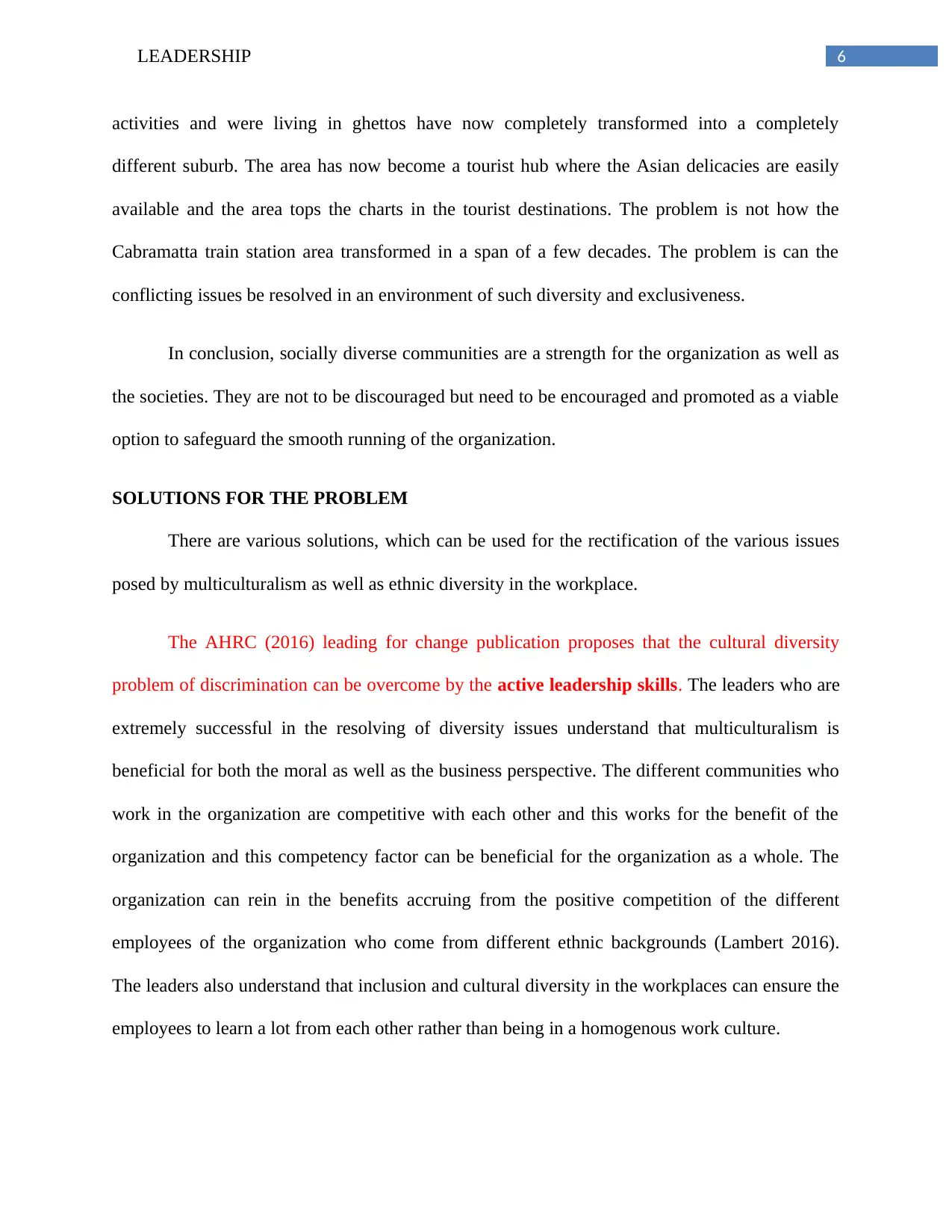
6LEADERSHIP
activities and were living in ghettos have now completely transformed into a completely
different suburb. The area has now become a tourist hub where the Asian delicacies are easily
available and the area tops the charts in the tourist destinations. The problem is not how the
Cabramatta train station area transformed in a span of a few decades. The problem is can the
conflicting issues be resolved in an environment of such diversity and exclusiveness.
In conclusion, socially diverse communities are a strength for the organization as well as
the societies. They are not to be discouraged but need to be encouraged and promoted as a viable
option to safeguard the smooth running of the organization.
SOLUTIONS FOR THE PROBLEM
There are various solutions, which can be used for the rectification of the various issues
posed by multiculturalism as well as ethnic diversity in the workplace.
The AHRC (2016) leading for change publication proposes that the cultural diversity
problem of discrimination can be overcome by the active leadership skills. The leaders who are
extremely successful in the resolving of diversity issues understand that multiculturalism is
beneficial for both the moral as well as the business perspective. The different communities who
work in the organization are competitive with each other and this works for the benefit of the
organization and this competency factor can be beneficial for the organization as a whole. The
organization can rein in the benefits accruing from the positive competition of the different
employees of the organization who come from different ethnic backgrounds (Lambert 2016).
The leaders also understand that inclusion and cultural diversity in the workplaces can ensure the
employees to learn a lot from each other rather than being in a homogenous work culture.
activities and were living in ghettos have now completely transformed into a completely
different suburb. The area has now become a tourist hub where the Asian delicacies are easily
available and the area tops the charts in the tourist destinations. The problem is not how the
Cabramatta train station area transformed in a span of a few decades. The problem is can the
conflicting issues be resolved in an environment of such diversity and exclusiveness.
In conclusion, socially diverse communities are a strength for the organization as well as
the societies. They are not to be discouraged but need to be encouraged and promoted as a viable
option to safeguard the smooth running of the organization.
SOLUTIONS FOR THE PROBLEM
There are various solutions, which can be used for the rectification of the various issues
posed by multiculturalism as well as ethnic diversity in the workplace.
The AHRC (2016) leading for change publication proposes that the cultural diversity
problem of discrimination can be overcome by the active leadership skills. The leaders who are
extremely successful in the resolving of diversity issues understand that multiculturalism is
beneficial for both the moral as well as the business perspective. The different communities who
work in the organization are competitive with each other and this works for the benefit of the
organization and this competency factor can be beneficial for the organization as a whole. The
organization can rein in the benefits accruing from the positive competition of the different
employees of the organization who come from different ethnic backgrounds (Lambert 2016).
The leaders also understand that inclusion and cultural diversity in the workplaces can ensure the
employees to learn a lot from each other rather than being in a homogenous work culture.
Paraphrase This Document
Need a fresh take? Get an instant paraphrase of this document with our AI Paraphraser
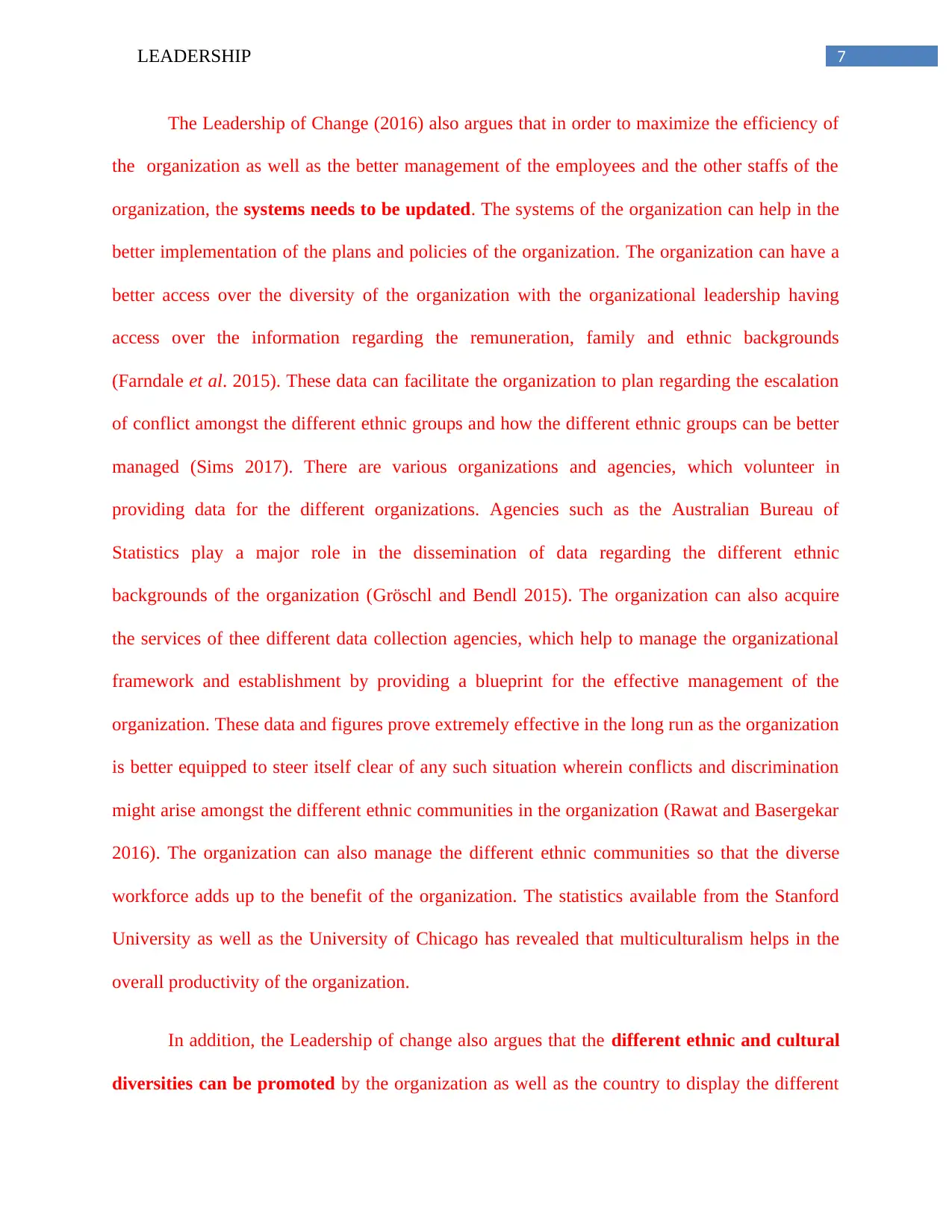
7LEADERSHIP
The Leadership of Change (2016) also argues that in order to maximize the efficiency of
the organization as well as the better management of the employees and the other staffs of the
organization, the systems needs to be updated. The systems of the organization can help in the
better implementation of the plans and policies of the organization. The organization can have a
better access over the diversity of the organization with the organizational leadership having
access over the information regarding the remuneration, family and ethnic backgrounds
(Farndale et al. 2015). These data can facilitate the organization to plan regarding the escalation
of conflict amongst the different ethnic groups and how the different ethnic groups can be better
managed (Sims 2017). There are various organizations and agencies, which volunteer in
providing data for the different organizations. Agencies such as the Australian Bureau of
Statistics play a major role in the dissemination of data regarding the different ethnic
backgrounds of the organization (Gröschl and Bendl 2015). The organization can also acquire
the services of thee different data collection agencies, which help to manage the organizational
framework and establishment by providing a blueprint for the effective management of the
organization. These data and figures prove extremely effective in the long run as the organization
is better equipped to steer itself clear of any such situation wherein conflicts and discrimination
might arise amongst the different ethnic communities in the organization (Rawat and Basergekar
2016). The organization can also manage the different ethnic communities so that the diverse
workforce adds up to the benefit of the organization. The statistics available from the Stanford
University as well as the University of Chicago has revealed that multiculturalism helps in the
overall productivity of the organization.
In addition, the Leadership of change also argues that the different ethnic and cultural
diversities can be promoted by the organization as well as the country to display the different
The Leadership of Change (2016) also argues that in order to maximize the efficiency of
the organization as well as the better management of the employees and the other staffs of the
organization, the systems needs to be updated. The systems of the organization can help in the
better implementation of the plans and policies of the organization. The organization can have a
better access over the diversity of the organization with the organizational leadership having
access over the information regarding the remuneration, family and ethnic backgrounds
(Farndale et al. 2015). These data can facilitate the organization to plan regarding the escalation
of conflict amongst the different ethnic groups and how the different ethnic groups can be better
managed (Sims 2017). There are various organizations and agencies, which volunteer in
providing data for the different organizations. Agencies such as the Australian Bureau of
Statistics play a major role in the dissemination of data regarding the different ethnic
backgrounds of the organization (Gröschl and Bendl 2015). The organization can also acquire
the services of thee different data collection agencies, which help to manage the organizational
framework and establishment by providing a blueprint for the effective management of the
organization. These data and figures prove extremely effective in the long run as the organization
is better equipped to steer itself clear of any such situation wherein conflicts and discrimination
might arise amongst the different ethnic communities in the organization (Rawat and Basergekar
2016). The organization can also manage the different ethnic communities so that the diverse
workforce adds up to the benefit of the organization. The statistics available from the Stanford
University as well as the University of Chicago has revealed that multiculturalism helps in the
overall productivity of the organization.
In addition, the Leadership of change also argues that the different ethnic and cultural
diversities can be promoted by the organization as well as the country to display the different
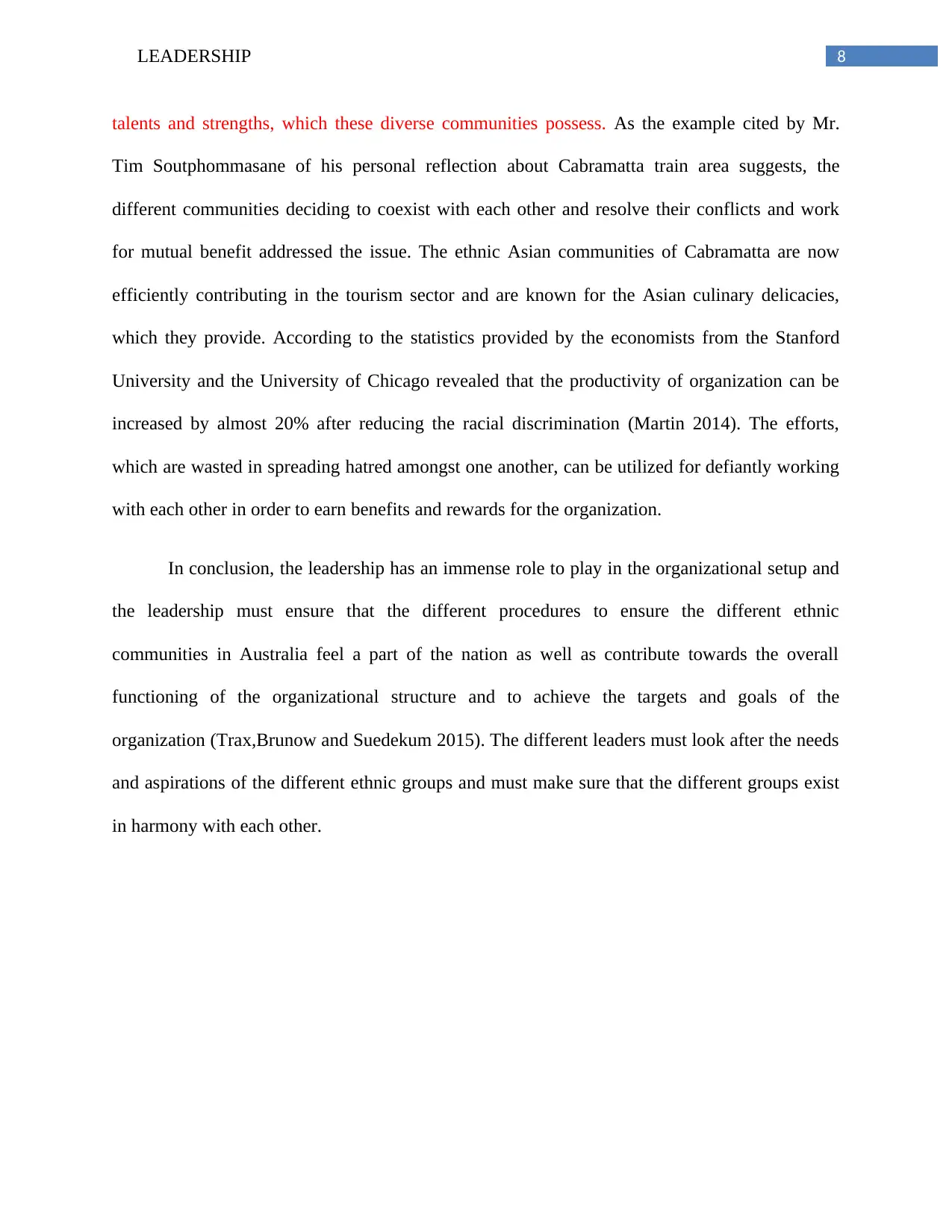
8LEADERSHIP
talents and strengths, which these diverse communities possess. As the example cited by Mr.
Tim Soutphommasane of his personal reflection about Cabramatta train area suggests, the
different communities deciding to coexist with each other and resolve their conflicts and work
for mutual benefit addressed the issue. The ethnic Asian communities of Cabramatta are now
efficiently contributing in the tourism sector and are known for the Asian culinary delicacies,
which they provide. According to the statistics provided by the economists from the Stanford
University and the University of Chicago revealed that the productivity of organization can be
increased by almost 20% after reducing the racial discrimination (Martin 2014). The efforts,
which are wasted in spreading hatred amongst one another, can be utilized for defiantly working
with each other in order to earn benefits and rewards for the organization.
In conclusion, the leadership has an immense role to play in the organizational setup and
the leadership must ensure that the different procedures to ensure the different ethnic
communities in Australia feel a part of the nation as well as contribute towards the overall
functioning of the organizational structure and to achieve the targets and goals of the
organization (Trax,Brunow and Suedekum 2015). The different leaders must look after the needs
and aspirations of the different ethnic groups and must make sure that the different groups exist
in harmony with each other.
talents and strengths, which these diverse communities possess. As the example cited by Mr.
Tim Soutphommasane of his personal reflection about Cabramatta train area suggests, the
different communities deciding to coexist with each other and resolve their conflicts and work
for mutual benefit addressed the issue. The ethnic Asian communities of Cabramatta are now
efficiently contributing in the tourism sector and are known for the Asian culinary delicacies,
which they provide. According to the statistics provided by the economists from the Stanford
University and the University of Chicago revealed that the productivity of organization can be
increased by almost 20% after reducing the racial discrimination (Martin 2014). The efforts,
which are wasted in spreading hatred amongst one another, can be utilized for defiantly working
with each other in order to earn benefits and rewards for the organization.
In conclusion, the leadership has an immense role to play in the organizational setup and
the leadership must ensure that the different procedures to ensure the different ethnic
communities in Australia feel a part of the nation as well as contribute towards the overall
functioning of the organizational structure and to achieve the targets and goals of the
organization (Trax,Brunow and Suedekum 2015). The different leaders must look after the needs
and aspirations of the different ethnic groups and must make sure that the different groups exist
in harmony with each other.
⊘ This is a preview!⊘
Do you want full access?
Subscribe today to unlock all pages.

Trusted by 1+ million students worldwide
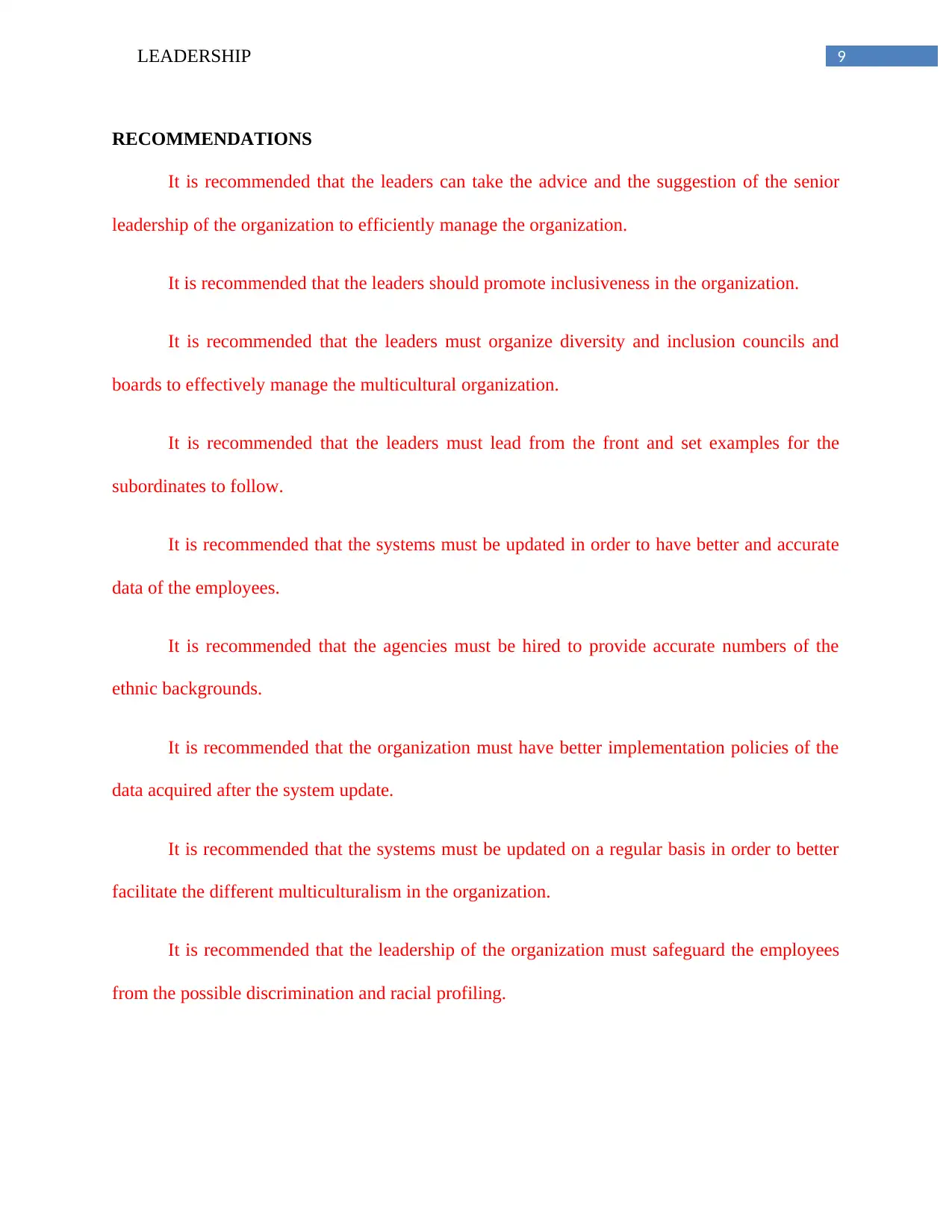
9LEADERSHIP
RECOMMENDATIONS
It is recommended that the leaders can take the advice and the suggestion of the senior
leadership of the organization to efficiently manage the organization.
It is recommended that the leaders should promote inclusiveness in the organization.
It is recommended that the leaders must organize diversity and inclusion councils and
boards to effectively manage the multicultural organization.
It is recommended that the leaders must lead from the front and set examples for the
subordinates to follow.
It is recommended that the systems must be updated in order to have better and accurate
data of the employees.
It is recommended that the agencies must be hired to provide accurate numbers of the
ethnic backgrounds.
It is recommended that the organization must have better implementation policies of the
data acquired after the system update.
It is recommended that the systems must be updated on a regular basis in order to better
facilitate the different multiculturalism in the organization.
It is recommended that the leadership of the organization must safeguard the employees
from the possible discrimination and racial profiling.
RECOMMENDATIONS
It is recommended that the leaders can take the advice and the suggestion of the senior
leadership of the organization to efficiently manage the organization.
It is recommended that the leaders should promote inclusiveness in the organization.
It is recommended that the leaders must organize diversity and inclusion councils and
boards to effectively manage the multicultural organization.
It is recommended that the leaders must lead from the front and set examples for the
subordinates to follow.
It is recommended that the systems must be updated in order to have better and accurate
data of the employees.
It is recommended that the agencies must be hired to provide accurate numbers of the
ethnic backgrounds.
It is recommended that the organization must have better implementation policies of the
data acquired after the system update.
It is recommended that the systems must be updated on a regular basis in order to better
facilitate the different multiculturalism in the organization.
It is recommended that the leadership of the organization must safeguard the employees
from the possible discrimination and racial profiling.
Paraphrase This Document
Need a fresh take? Get an instant paraphrase of this document with our AI Paraphraser
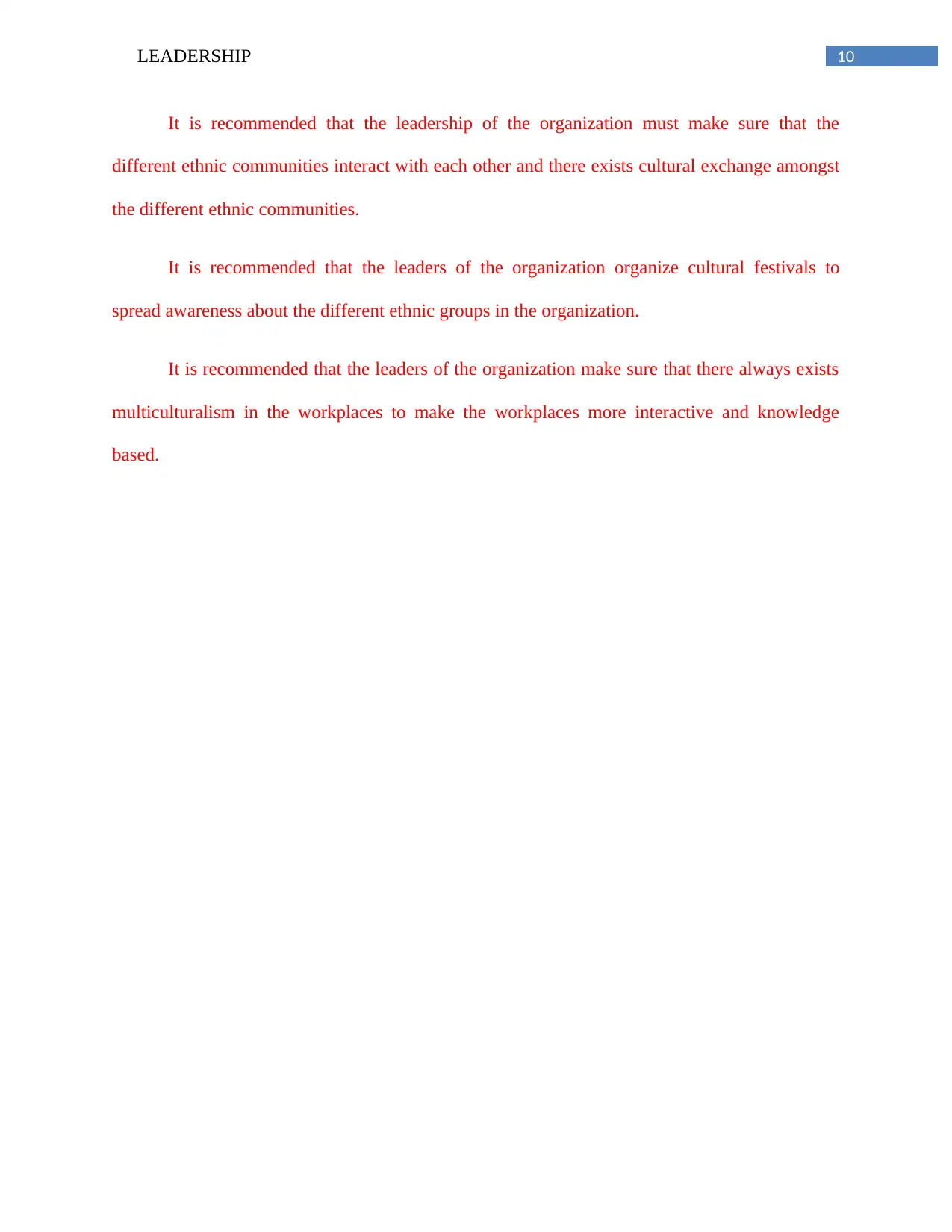
10LEADERSHIP
It is recommended that the leadership of the organization must make sure that the
different ethnic communities interact with each other and there exists cultural exchange amongst
the different ethnic communities.
It is recommended that the leaders of the organization organize cultural festivals to
spread awareness about the different ethnic groups in the organization.
It is recommended that the leaders of the organization make sure that there always exists
multiculturalism in the workplaces to make the workplaces more interactive and knowledge
based.
It is recommended that the leadership of the organization must make sure that the
different ethnic communities interact with each other and there exists cultural exchange amongst
the different ethnic communities.
It is recommended that the leaders of the organization organize cultural festivals to
spread awareness about the different ethnic groups in the organization.
It is recommended that the leaders of the organization make sure that there always exists
multiculturalism in the workplaces to make the workplaces more interactive and knowledge
based.
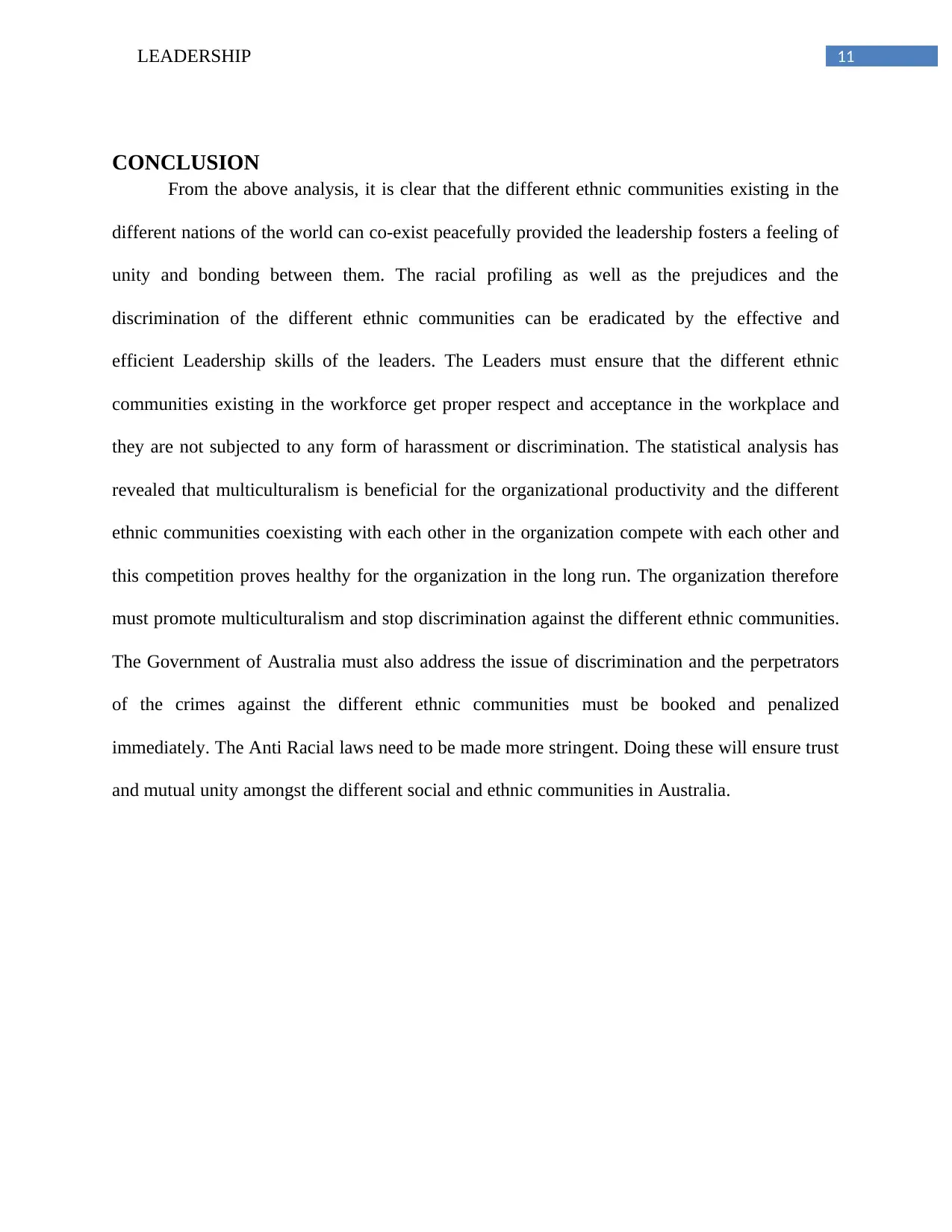
11LEADERSHIP
CONCLUSION
From the above analysis, it is clear that the different ethnic communities existing in the
different nations of the world can co-exist peacefully provided the leadership fosters a feeling of
unity and bonding between them. The racial profiling as well as the prejudices and the
discrimination of the different ethnic communities can be eradicated by the effective and
efficient Leadership skills of the leaders. The Leaders must ensure that the different ethnic
communities existing in the workforce get proper respect and acceptance in the workplace and
they are not subjected to any form of harassment or discrimination. The statistical analysis has
revealed that multiculturalism is beneficial for the organizational productivity and the different
ethnic communities coexisting with each other in the organization compete with each other and
this competition proves healthy for the organization in the long run. The organization therefore
must promote multiculturalism and stop discrimination against the different ethnic communities.
The Government of Australia must also address the issue of discrimination and the perpetrators
of the crimes against the different ethnic communities must be booked and penalized
immediately. The Anti Racial laws need to be made more stringent. Doing these will ensure trust
and mutual unity amongst the different social and ethnic communities in Australia.
CONCLUSION
From the above analysis, it is clear that the different ethnic communities existing in the
different nations of the world can co-exist peacefully provided the leadership fosters a feeling of
unity and bonding between them. The racial profiling as well as the prejudices and the
discrimination of the different ethnic communities can be eradicated by the effective and
efficient Leadership skills of the leaders. The Leaders must ensure that the different ethnic
communities existing in the workforce get proper respect and acceptance in the workplace and
they are not subjected to any form of harassment or discrimination. The statistical analysis has
revealed that multiculturalism is beneficial for the organizational productivity and the different
ethnic communities coexisting with each other in the organization compete with each other and
this competition proves healthy for the organization in the long run. The organization therefore
must promote multiculturalism and stop discrimination against the different ethnic communities.
The Government of Australia must also address the issue of discrimination and the perpetrators
of the crimes against the different ethnic communities must be booked and penalized
immediately. The Anti Racial laws need to be made more stringent. Doing these will ensure trust
and mutual unity amongst the different social and ethnic communities in Australia.
⊘ This is a preview!⊘
Do you want full access?
Subscribe today to unlock all pages.

Trusted by 1+ million students worldwide
1 out of 14
Related Documents
Your All-in-One AI-Powered Toolkit for Academic Success.
+13062052269
info@desklib.com
Available 24*7 on WhatsApp / Email
![[object Object]](/_next/static/media/star-bottom.7253800d.svg)
Unlock your academic potential
Copyright © 2020–2025 A2Z Services. All Rights Reserved. Developed and managed by ZUCOL.




